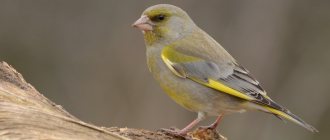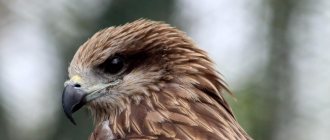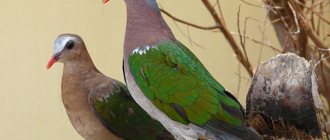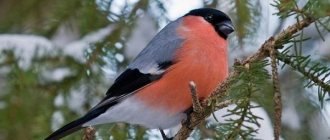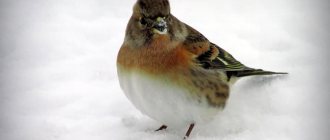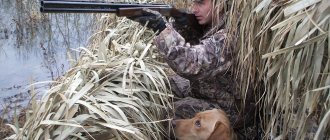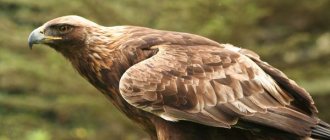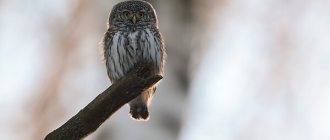The Canary finch, or simply the canary, is a bird of the finch family.
The canary is a native inhabitant of the Azores and Canary Islands. About 90 thousand pairs of canaries live in the Canary Islands, and in the Azores the population is approximately 60 thousand pairs.
Canary (Serinus canaria).
These birds also live in Madeira, but their numbers there are much lower - 5 thousand pairs. They tried to breed canaries in the Hawaiian Islands and Bermuda, but they did not survive there. Canaries were brought to these islands in 1930, and by mid-1960 all individuals died.
Today, the Canary finch is found in Puerto Rico. What awaits this population in the future is unknown.
What does a canary look like?
| Name | The Canary Finch Serinus canaria is a species of wild bird from which all currently known species of canaries originate. |
| Length | 0.1-0.2 m |
| Adult weight | 0.01-0.03 kg |
| Color | Varied (depending on the subspecies) |
| Beak | Short, pin-shaped |
| Eyes | Round, small, dark. |
| Tail | Bends under a crescent-shaped perch. |
| Sexual dimorphism | By external characteristics: - males have a longer tail; - Females have a flat cloaca. When singing, the throat of males swells, but that of females does not. According to behavior: - Only the male canary sings melodiously and loudly. — During the mating season, females become passive. The sex of a chick can only be determined accurately using a DNA test. |
Character and training of canaries
The nature of the birds is quite calm and accommodating, and males are more friendly towards humans than females. But at the same time, if the bird came to a person at a more mature age, they may be reluctant to make contact and in some cases even show mild aggression.
Since they have already formed a certain character, and birds rarely change their habits. To change the character of an adult, you need to make a lot of effort and have great patience.
If the individual is young, then here too you need to show patience and calmness; during the first days of the bird’s stay in the house, you should disturb it as little as possible, and approach its habitat only to change food, and you should not make any impetuous or sudden movements.
When the domestic canary gets used to the new place, you can begin to gradually tame it. The cage should be positioned so that it is at eye level, and you should go into the room where the bird is located more often, then you can even sit next to the cage. You can even start talking to her in a quiet and gentle voice.
Note!
- How to choose a mattress and not make a mistake? Review of the best models, size table
- Cotton blanket: advantages and disadvantages, rules of choice and care
- Review of ideas for exterior home decoration
When the canary freezes and seems to listen to the words, you can begin taming your hands. To do this, you need to carefully insert your hand with a tasty treat into the cage. Sooner or later the bird will get used to the hand and will sit on it.
Under no circumstances should you shout at it, shake the cage or generally offend it; as a result of such an attitude, the bird will completely refuse to have a relationship with a person.
How is it different from other birds?
- They do not like to be handled (in practice, such manipulations should be avoided).
- The main activity is singing, jumping on poles and eating food.
- Small sizes.
- They get used to well at home (even alone).
- They are not picky about care (they do not require much attention, do not have any special gastronomic preferences, and are neat).
- They sing beautifully.
House canary (Serinus canaria)
| Squad | Passeriformes |
| Family | Finches |
| Genus | Canary finches |
In the photo: canaries
Humans tamed the wild Canary Canary more than 500 years ago; enormous selection work was carried out on the species, which helped to obtain a great variety of varieties and breeds of domestic canaries, which differ in color, appearance, and singing characteristics. It is believed that at the moment more than 12,000 varieties and breeds of domestic canaries have been bred by humans, which are usually divided into 3 groups - decorative canaries, colored canaries and singing canaries.
Ornamental canaries have different sizes, body shapes or modified plumage. The most notable of this group are the humpback canaries, crested and Norwich canaries, and various curly canaries. Colored canaries come in a variety of colors (red, orange, variegated, yellow, gray, green, etc.) The most desirable of this group of breeds for collectors and hobbyists are red canaries. Song canaries include breeds bred to improve their singing qualities. Only males sing in domestic canaries; females also make a certain number of sounds. Breeds of this group include German, Belgian, Spanish, American, and Russian song canaries. They all have a different “song,” but external data is not so important for these birds.
Canaries are very pleasant birds to keep at home; they are not as noisy as parrots; for example, they also produce less litter. They are quite easy to tame and trust humans. However, these birds are created to be admired, listened to, but not carried in hands. They are not trained to imitate human speech or perform various tricks, like parrots. These birds are quite fragile and require attention in their care. Canaries reproduce well in captivity.
Lifespan of canaries
with proper care it lasts 7 - 12 years.
Habitat and lifestyle
The homeland of canaries is the Canary Islands (hence the name of the genus), the islands of Madeira and Cape Verde, where the wild population still lives. From 16th Art. These singing birds were brought to the European continent, where they willingly took root next to people and from where they spread across all continents.
Canary finches live in the wild in large or small flocks, within which there is certainly a lot of “communication”. Their day is spent entirely in search of food to the sound of melodic trills. Birds go to sleep in a large flock on tree branches.
Interesting Facts
- There was a time when canaries (particularly Hartz rollers) were used in the coal industry. Due to the fact that birds are very sensitive to the methane content in the air, miners took the songbird with them into the mine. While the bird sang, they worked. If suddenly the bird stopped singing, work stopped, and this served as a reason for the miners to urgently go upstairs, because it meant that the concentration of toxic gas was increasing.
- The Canary bird is the only species with a fully studied genome (in 2014, complete genome sequencing took place based on domesticated subspecies).
- Over 500 years of living with people, canaries have changed - their vocal apparatus has changed, and their singing has become very different from their wild relatives.
- It has been proven that the canary's hearing perceives sounds from 1 to 10 thousand Hz.
Description and features
The canary has surpassed the size of its wild ancestor, the Canary finch. In songbirds and colored birds, the body length reaches 15 cm. Breeders have developed a decorative appearance. They are small, 12 cm, and larger ones grow up to 24 cm.
The singing creature adopted from the finch:
- harmonious forms;
- round shaped head;
- short pin-shaped beak.
The most famous plumage of the canary is yellow.
But on the market, poultry farmers have the following colors:
- white;
- red;
- brown.
Scientists tried to cross a canary with a fire siskin and got red birds. Breeders have developed various bizarre forms with tufts on the head and curls. Their flight path is similar to that of finches, reminiscent of the pattern of rough sea waves.
Birds easily adapt to their environment and change feather shades without the help of breeders; they are affected by the conditions of their detention or place of natural life, climate and the composition of substances in the diet.
These creatures are very sensitive to danger; they sense emissions of natural gas. The production workers even went down into the mine with the bird, when it began to rush around, as if giving a signal to people about an imminent explosion, the miners quickly left the dangerous area.
Individuals are excellent imitators of other voices. They remember the chirping and accurately reproduce the sounds of sparrows, tits - any feathered neighbor who has settled nearby. Canaries sing like professional singers, starting with chanting in a quiet tone and gradually increasing the sound of the notes. When they go into a frenzy, the aria will be heard not only by the household, but by the entire district.
What does it eat?
A balanced diet for a canary is the key to its health and longevity. It should include:
- grain or ready-made industrial grain mixtures for this type of bird (rice, crushed corn, rapeseed, yellow or red millet, canary seed, hemp seeds, white sorghum, flaxseed or sunflower seed);
- nuts;
- vegetables (tomatoes, cucumbers, zucchini);
- fruits (apples, apricots, cherries, peaches, grapes) and juices from them;
- branch food (apple tree, cherry, raspberry, currant, alder, rowan, elderberry, maple, linden, birch, viburnum, aspen, beech);
- greenery, grass.
Birds should eat only fresh and high-quality food, and their cages should always have a drinking bowl with clean water.
Human cruelty or the feat of a small bird
However, this wonderful story also has a flip side. People also needed little singers in another capacity - as gas analysts.
The seventeenth-century mining industry had not yet invented devices that could quickly and accurately test for the presence of firedamp. But the workers thought of taking canaries with them into the mines. The birds were keenly aware of the smell of methane and carbon monoxide. They died even if there was a small amount of it in the air.
The miners closely monitored the well-being of the birds. And when they began to worry, fell silent or fell unconscious, the workers managed to leave the mine in time. Rescuers exploring emergency mines also used canaries for the same purpose. It is impossible to calculate how many lives these little birds saved.
Over time, they came up with humane ways to use birds - special sealed cages. They were closed as soon as the canaries began to feel something. To prevent the birds from suffocating, oxygen was allowed into the cage.
The phraseology “canary in the mine” has gone from miners and rescuers to the people, which is used as a signal of danger.
Care instructions
- After purchase, the bird should be kept in quarantine for two weeks.
- During molting, add high-protein food (boiled eggs, small insects, larvae) to the bird's diet.
To maintain the bright red color of the feathers of some bird subspecies, their diet should include spirulina, carrots, sweet potatoes and vegetables with dark green leaves.
- Once every 1.5-2 months, canaries need a haircut - trimming their wings (reduces the risk of escape) and claws;
- To feed feathered pets, it is better to use special food for this type of bird (when using grain and seeds, you should additionally give vitamin and mineral premixes);
- Recommended cage parameters – from 0.25x0.25x0.45 m;
- Adhere to a day cycle close to the natural environment (short days in winter and long days in summer);
- Do not allow birds into the reach zone: - mosquitoes; - Teflon dishes; - threads, yarn, fiber; - tobacco, cigarettes, smoke from them; — pesticides and other poisons; — flowerpots with poisonous leaves; - sweets, chocolate, salt, alcohol; - products made of cedar or mahogany; — heavy metals (zinc, lead) and items made from them; — air fresheners, fragrances, aroma candles.
Care and maintenance at home
The songbird is unpretentious, caring for them is not difficult and does not depend on the species chosen by the owner. You just need to master the basic conditions and care that will surround the birds. Canaries need to build or buy a ready-made cage.
The poultry house should not be decorated with decorative frills, domes and additional extensions. The simple shape will be convenient for amazing creatures and will not create difficulties for the owner in cleaning. The dimensions depend on the purpose of the plant. For a single Kenora, a spacious rectangular box is enough.
For breeding it is necessary to separate places of residence:
- there will be a male in one cage;
- the second house will be needed for crossing and reproduction;
- the third place of residence is intended for the female and growing chicks.
The canary cage has plywood or plastic back walls, and the front side should be mesh or lattice. 2 doors are installed, on which a hanging nest and a bathing shelf will be equipped; through such openings the owner will clean the room.
From the devices, poles are hung so that the birds can fly from one crossbar to another. The diameter of the poles is chosen to be 14mm. They are easy to place and comfortable to hold. Different feeders are placed to add mineral fertilizer, grain and soft food. Birds love to take water baths. Attach a hanging tray or place a shallow trough on the floor.
The drinking bowl is mounted so that it is convenient for filling. All care consists of hygienic maintenance, timely removal of garbage and food debris. The water needs to be changed periodically when it gets dirty; pets don’t like dirt and can’t stand it. You should ensure that the grain does not become moldy - this is a source of infection, bacteria and disease.
Like ordinary pets, canaries love room temperature; drafts are dangerous for them. Therefore, you need to think about where to keep birds. The cage is placed away from radiators and air conditioners; it is better to close the window where the bird house is located.
You should not place the poultry house in the kitchen. Constantly changing temperatures, fumes and odors from cooking will not be beneficial. A strong recommendation is to keep the house in places that are difficult for other animals to reach. So that they do not have the opportunity to throw the house off the windowsill and get to an interesting hunting object.
The birds' habitat should be warm, light and dry. The sun's rays, if they are not scorching, will not interfere with normal development. In summer, pets feel good on balconies or loggias. Cleaning is done regularly, but you can’t let a bird go for a walk so that it can perform its intimate affairs there.
Therefore you need to think:
- about the removable tray;
- excrement-absorbing litter;
- sand on the floor surface;
- absorbent paper.
The owner must decide for himself what is more convenient for him to change and how easier it is to clean.
Reproduction
The breeding season falls between March and April. During this period, the female lays 5 bluish-green eggs, which she incubates for 13 days. Both feathered parents are involved in feeding the offspring. From 3 months of age, the chicks begin to leave the nest, and by 6 months they become fully sexually mature.
Canaries can reproduce well even in captivity. In addition, they can mate with siskins and other passerines. But the offspring from such matings are born fertile and do not live long.
Justice has triumphed
Cautious sellers sometimes confused canaries and kenars due to the similarity of colors and sold females instead of males. And rich people had the opportunity not only to put canaries in golden cages with precious stones, but also to create conditions for them that were close to natural.
As a result, the canaries managed to adapt to life in captivity and began to reproduce. Many people took advantage of this opportunity. There were more and more birds, their prices fell rapidly. Now even the lower strata of the population could afford to buy a canary. Birds reached the peak of their popularity by the early seventeenth century.
Everyone could enjoy the beautiful singing of little birds. It could come from anywhere: from luxurious houses and from poorer houses, from shops, studios, taverns. Many people found peace in caring for singing pets, rejoicing and relaxing next to them.
Classification
For more than 500 years, people have managed to study canaries as much as possible and develop almost 12 thousand of their varieties. Birds are classified into three groups, which in turn are divided into subgroups and subspecies.
| Group | Decorative | Colored | Singers |
| Subgroup | • Crested | • Melanin (dark) | |
| Peculiarities | They have a specific “bang-cap” on the parietal part of the head. They live up to 15 years. A specific feature is that you cannot cross two crested pets, since all their offspring will be lethal. For breeding, you should take one crested individual and one with a smooth head. | The color of a feather is determined by the presence of dark pigment. | They have a high-pitched voice, thanks to which they produce wonderful trills. |
| Examples of subspecies | - German Crested; - Lancashire; - English Crested; - gloucester. | — black (green, black, gray, bronze, copper, red-black); — agate (silver); - brown; - isabella (pink). | — German (Harz roller); - Belgian (Malinois); - Spanish (timbrados); — Russian (not recognized by the international community). |
| Subgroup | • Curly | • Lipochromic (light) |
| Peculiarities | Unpretentious birds with smooth thin feathers, the length of which reaches 20 cm. They live for about 20 years. | Due to a small amount or complete absence of pigment (“alibinism”), bird feathers are light. |
| Examples of subspecies | - Norwich; - Bernese; - Spanish decorative; - Yorkshire; — border; - mini-border. | - yellow; - white (English and German); — red (mosaic, orange); - Ivory; - with red eyes. |
| Subgroup | • Curly |
| Peculiarities | They have a specific curliness due to the curling of feathers along the entire length. Most birds are large, reaching 17-20 cm in length (with the exception of the Japanese canary). |
| Examples of subspecies | — Parisian curly (trumpet); - French curly; - Swiss curly; - Italian curly; - Paduan or Milanese curly; - Japanese curly (makij); - northern curly; - Fiorino. |
| Subgroup | • Humpbacks |
| Peculiarities | The main difference is the non-standard appearance. The head is lowered much lower than the shoulders, which causes a “hunchback” effect. Rarely found in nurseries. |
| Examples of subspecies | - Belgian humpback; - Scottish; — Munich humpback; - Japanese humpback. |
| Subgroup | • Painted |
| Peculiarities | The appearance of color begins after the first year of molting and lasts up to three years. Then the bright plumage begins to “fade out” and within 2-3 years becomes almost invisible again. They are not particularly popular among breeders, since changes in color after hybridization have damaged their singing abilities, and these birds are considered less sweet than their relatives. |
| Examples of subspecies | - London; - lizard. |
Video Starting a canary. Interesting facts about canaries
Popular types
Over a long period of breeding the species in captivity, breeders obtained many breeds. Breeds of canaries differ from each other in body size and shape, feather structure, color and voice. Among the most common varieties are the following:
- Gray. Birds of this color are obtained by crossing black and white individuals. They have plumage of various shades of gray. In good lighting, a bluish tint is noticeable.
- Yellow. This is a classic canary color. It appeared in the process of domestication as a result of mutation. Birds of this color have reduced melanin content in their feathers.
- Humpbacked. This breed differs from others in its unique body structure. It is characterized by a vertical type of posture, in which the torso is located almost perpendicular to the floor. At the same time, the head is strongly lowered, which is why the bird looks “humpbacked”.
- Mosaic. This breed is characterized by a combination of several colors in its color. The main tone is white or gray. There are bright red spots on the head, wings, chest and rump.
- Gloucester. Birds of this breed are distinguished by elongated feathers on their heads, which create a semblance of a “cap”. Thin long feathers hang down, covering the bird's eyes and reaching the beak. The color can be different - white, brown, yellow, motley.
- Orange. Birds of this color are obtained by crossing red and yellow individuals. The intensity of the shade may vary depending on the combination of pigments. Pale colored individuals are called salmonids.
- Red. Birds of this breed have a rich red color. It was obtained by crossing the canary and its related species, the fire siskin. Their singing abilities are believed to be inferior to other species.
It all started with green
The natural color of a wild specimen is green. On top, the bird's feathers are colored green with a gray tint. The belly has a yellowish tint. The canary appears to have colorful feathers. This feeling is created by dark gray stripes running almost throughout the bird’s body.
The first canaries that were kept in captivity had a natural plumage color. Now the wild color is not so common. Mostly yellow birds are popular. Other colors of their plumage are also known: white, orange, brown, gray and others. This is discussed in the article “Russian canaries and other species.”
Canary feeding technique
It is better to determine the amount of food per day experimentally, since canaries, even with the same method of keeping and age, have different appetites. On average, one canary during the resting period (autumn-winter) needs 1-1.5 teaspoons of grain mixture per day, as well as some additional feed.
Canaries should be fed daily in the morning, pouring the full amount of grain mixture, and additional food during the resting period is given two to three times a week. With the onset of the nesting season, especially when the chicks appear, you should feed more often and provide more additional food (as needed).
During the period of feeding the chicks, as well as for two weeks after their departure from the nest, the young should be fed as needed and given soft food (porridge, carrot-sugar mixture, etc.). At the age of approximately 6 months, the young animals are gradually transferred to rationed feeding and their fatness is monitored.
It is useful to give porridge to females and chicks with fish oil at the rate of a drop per teaspoon of soft food. If young animals eat soft food willingly, then at the age of 20 days they can be given other additional food, including fresh greens.
When feeding adult canaries and young animals, in order to avoid the occurrence of diseases and death of birds, the following preventive measures must be taken.
1. When buying grain feed, check that it is not musty, moldy and rancid (taste it), pickled with formaldehyde or any other poisons (seed grain is usually pickled to protect it from insects).
2. You need to store food in a cool, but not damp place, stir it often, ventilate it, air dry it, spreading it on a sheet of paper in a thin layer.
3. Soft food should only be prepared for one day. Place it in the feeder more often in hot weather; in cold weather in the summer, less often and in small quantities, so that the food does not spoil from the heat. You cannot leave soft food in the feeder overnight; it will turn sour and become unsuitable for feeding.
4. The grain mixture must be sifted through a sieve to remove debris and dirt. This food is placed in a feeder separate from other feeds.
5. On the day when the birds are offered additional feed, the grain mixture is given at a reduced rate.
6. During the period when the female is feeding the chicks, as well as when the young are separated from their parents, in the first months the food is given without the norm and only as much as they can eat, without leaving any leftovers for subsequent feeding.
7. Do not provide drinking and bathing water directly from the tap. It should be prepared the day before so that it is not cold and so that the chlorine is released from it. The water temperature should be room temperature (+18 +20°C), it is advisable to change it as it gets dirty, especially in the summer. The drinking bowl should be suspended inside the cage and not placed on the floor so that the birds do not pollute it.
8. A separate small jar must contain clean river sand mixed with crushed chicken egg shells. Before mixing, the sand must be thoroughly washed, calcined on a gas burner, after which it can be mixed with crushed shells. After grinding, the shells must be sifted through a fine sieve to prevent the death of birds from injury to the gastrointestinal tract by large pieces. Mineral feeds should be replaced with fresh ones when soiled.
Lifestyle
They inhabit sparse forests, forest edges, groves with copses, gardens and parks. In the northern parts of the range it is migratory, in the south it is sedentary. In spring they return from the south quite early, in the first half of March in the south, in early April in the north of the range, and soon break up into pairs. At this time, lekking flights of males can be observed. They feed on both plant and animal foods. In summer they feed mainly on insects - beetles, ants, etc., in the second half of summer and autumn - on berries, buds and seeds of herbaceous plants.
The flight form is a bit like the flight of a bat. Jumps with both legs, flies quickly and makes arcs in the air, and hovers for a while before landing. For a diving flight, it takes off sharply, spins several circles at a fairly high altitude and, with its wings attached, rushes down. In the wild they live up to 13 years.
Succulent plant food
Fruits, vegetables, berries and fresh herbs, like soft food, are classified as additional, but unlike soft food, they should be given to canaries in plenty, as they are a source of vitamins and some minerals. They are given mainly in finely chopped form, the berries mixed with soft food or separately whole. The fruits most often fed to canaries are sweet apples, peaches, apricots, cherries and grapes, given in small pieces.
The vegetables that are mainly used are the already mentioned carrots, as well as red beets and cabbage. Beets are fed in grated form, sometimes mixed with crushed white breadcrumbs.
Fresh greens are an essential part of the diet and should be offered daily. If canaries receive greens (lettuce, chickweed, Tradiscantia leaves, spinach, etc.) in sufficient quantities, they usually do not need supplements of vitamins and minerals, except calcium and phosphorus. The best fresh herb is woodlice, which can be collected almost throughout the year. Sometimes it is even extracted from under the snow, since it is not afraid of freezing and after thawing, the stems and leaves of this grass retain their former freshness and elasticity. Woodlice grows in damp places with loose soil, especially in vegetable gardens and potato beds.
Spinach ranks first in terms of mineral content. It contains a large amount of iron. In addition, spinach is rich in vitamins and stimulates the appetite. It is fed mixed with protein supplements (hard-boiled chicken eggs, egg powder, etc.). Spinach also prevents canaries from plucking feathers. However, it must be given in small quantities, especially at first, otherwise it may cause diarrhea.
Crosswort is also a common plant; young canaries readily eat it. It contains a significant amount of iron. Another weed, dandelion, can use both young leaves and seeds. The substances it contains promote blood circulation, enhance digestion and improve appetite.
In winter, canaries can also be fed fresh greens. To do this, it is grown in boxes, which are filled with a mixture of sawdust and earth (5:1), sown with meadow grass seeds or wheat, watered with water and placed in a bright place. The seeds germinate quickly, and they are given to the canaries, having first been washed with water from the ground and dried a little in the shade in the wind to remove moisture.
Singing
Fragment of the greenfinch song
They begin to sing in early spring on migrations, they sing most actively in April - May, then at times throughout the summer. The song consists of a leisurely alternation of various sonorous trills and chirps, of which the most prominent is the buzzing “jzhzhjuyuyy” or “vzhzhzhzheee”. In addition, the song has a characteristic rolling trill, consisting of round beads. The current male sits on the top of a tree, sings loudly and at times, singing, flies into the air, where, spreading his wings and tail, he soars for some time in a gliding flight, and then descends again to his original place or in the neighborhood.
Literature
| Wikisource has texts on the topic: “ Greenfinch ” |
- Animal life: In 6 volumes - Volume 5: Birds / ed. N. A. Gladkova, A. V. Mikheeva. - M.: Education, 1970. - 675 p.
- Ostapenko, V. A.
Birds in your home: A reference guide. - M.: Arnadia, 1996. - ISBN 5-88666-011-9. - Ryabitsev, V.K.
Birds of the Urals, the Urals and Western Siberia: A reference guide. - Ekaterinburg: Ural University Publishing House, 2001. - 608 p. — ISBN 5-7525-0825-8.
